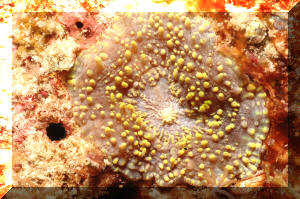Ever since complex animal life appeared, the various species of Cnidarians (corals, see anemones, jellyfish etc) have been keystone species in the worlds oceans, and they remain so to this day. The coral reefs of this world are of course composed of stony corals, forms which extract calcium and other elements from sea water and use them to build their hard exoskeletons. There are probably even more “soft” corals on the reefs, which have either a hydrostatic or flexible skeleton to keep them upright. In aquaria, probably the commonest soft corals you will see are various forms of Actinodiscus or Discosoma. I say forms rather than species, as the taxonomy of the group is seriously complex. It is known from other Cnidarian groups that the same species can appear very different depending on circumstances, and also different species can appear practically identical. It is probable that the different forms have subtly different ecological niches, preferred food, or geographical range, but it is practically impossible to look at a captive specimen and identify it. The only certain way would be to do a DNA analysis, but the requisite reference work has itself not been done – it would make a good project for a university student I suspect to analyse as many different forms as possible and at least arrive at a ball park figure.
Mushroom polyps belong to a group called the Corrallimorpha. Some of this group can grow extremely large – over 50cm across- but Discosoma species usually average 5-6cm. The body form is as you would expect from the name, with a flat disk on top of a short stalk. The disk is usually held so as to receive maximum sublight, as mushroom polyps (like stony corals) harbour dinoflagellate algae in their tissues which supply much of the food requirements. They can also absorb particulate matter from the surrounding ocean, and probably directly absorb some chemical nutrients as well.
They often inhabit areas with a higher than average load of organic compounds compared to the main reefs, such as back-reef areas, and their fondness for shallow water means they are used to fairly large temperature variations as well. All this goes towards an animal which is much hardier in the aquarium than stony corals, which have more exacting requirements. It has not been studied as far as I am aware, but I wonder if the (presumably) more tolerant algae in Discosoma can swap host species with stony corals? Coral bleaching occurs when stressed stony corals eject non-functioning algae, but they sometimes recover when the algae are replaced. As these algae have to come from somewhere, and Corallimorphans and stony corals are closely related, I wonder if Discosoma colonies might act as reservoirs of suitable algae, hastening recovery?
Discosoma sp. Reproduce well in aquaria, usually by budding or division. They can build up their numbers quite quickly, and this can be a problem if they start to encroach on other corals in the tank. People often forget that corals are animals, and sometimes quite territorial ones. Some forms produce stinging tentacles to damage their opponents, other produce chemical toxins. As the battles often take place overnight, and often take weeks or months, aquarists may not notice what is happening until one or other is too damaged to survive. Any corals need to be well spaced out to avoid trouble.
As well as being aquarium animals, the various forms of Discosoma have recently acquired a new importance in biology. They are a source of a variety of fluorescent proteins, which can be used for tagging biological reagents or spliced genes in lab animals. Exposing the animal carrying the protein to ultraviolet light causes the fluorescence which shows how the gene has been taken up.
That concludes the aquarium tour. I hope you liked it. Next week, a few one-off posts will start.
(images from wikipedia, wetwebmedia.com)



No comments:
Post a Comment